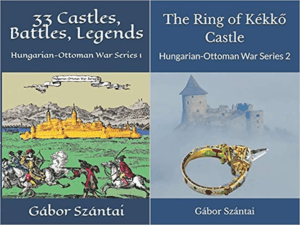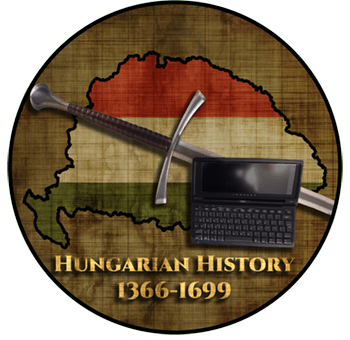She was the daughter of the Cuirassier Captain Nádasdy I. Ferenc and Terjék Orsolya. Nádasdy Anna was the sister of Nádasdy Tamás, later Palatine, and was born in the first half of the 1510s. She had several brothers and sisters, besides Tamás, Kristóf, Márton, Jakab, László, as well as Zsuzsanna and Krisztina. Her childhood seems to have been different from that of other noble daughters of the time.

Her later letters suggest that she was well educated, and her elaborate, neatly handwritten letters indicate a higher education. She may also have had an insight into Latin. She may have spent her childhood on the ancestral family estate of Nádasd.
Her brother, who had formed a friendship and alliance with the powerful Transylvanian landowner Mayláth István in 1526 and had served under King Szapolyai János since 1529, also wanted to persuade his friend to leave King Ferdinand’s side. After he succeeded, in 1530, he married Anna to Mayláth and ceded the castle of Fogaras to them. The couple had two children, Gábor and Margit.

We don’t know what the relationship between the Mayláth-Nádasdy couple was like, but later records suggest that it was balanced, perhaps even intimate, as Anna did everything she could to free her husband after he was captured. Had their relationship been bad, she would not have fought for his release.
In 1534, Mayláth became the Voivode of Transylvania, but he became more and more independent, rebelled against King Szapolyai, and after his death, he even wanted to break Transylvania away from the kingdom. To this end, he tried to ally himself with the Turks, but Sultan Suleiman refused to accept his terms.
He sent the Voivode of Moldavia against him, who besieged Fogaras, then deceived the Voivode and took him prisoner. The prisoner was taken to Istanbul, where he was imprisoned in the infamous Seven Towers with Török Bálint, who was also captured at the same time.

His wife remained in Transylvania, and from then on, her main goal was to free Mayláth. She wrote to her brother, she wrote to Martinuzzi György, to Queen Isabella, and anyone else she thought could help. There were signs of hope, but the Sultan never released the important prisoners.
Török Bálint died around August 1550, and Mayláth around mid-December. The news that his wife and children had been driven from Huszt castle by Ferdinand’s soldiers may have contributed to his deteriorating condition. Csányi Ákos, the chief prefect of Nádasdy Tamás in Kanizsa, even mentioned the incident to his master in early 1557.

As early as 1551, Nádasdy Anna wrote to her son, who was brought up at the court of Nádasdy Tamás, that he could blacken his boots:
“My loving Lord, your loving father has been taken out of this world by the Lord God. And what is very sad to me, because of the death of my beloved husband, is even more sad, that you were orphaned by your beloved father when you were so young, and that you did not know your beloved father at all. But I think it was well with God.”

Like the attempt to rescue her husband, the effort to bring his body home was unsuccessful, even though Anna wrote to the Grand Vizier, Rustem Pasha, in vain. She wished to make Majláth Gábor the heir of the childless Nádasdy couple, and the combined fortune would have made the boy the richest lord of the country. His mother beckoned:
“Above all, fear God, and the Lord Comes, Nádasdy Tamás, and honour the Lady, and obey all their commands, for they are your parents, to whom God has given you.”
After the attack on Huszt Castle, and even though she stayed in Transylvania for a while, she married off his daughter, who was married to Báthory András of Somlya in late April 1551. This means that Mayláth Margit was born in the mid-1530s, Gábor may have been younger, since in 1551 his mother described him as still small, i.e., he must have been a child, 12-13 years old.
Afterwards, Anna also moved to her brother’s court in Sárvár. This may have been related to the fact that Nádasdy arrived in Transylvania in the second half of 1551 as a royal governor and left in early December (before the murder of Martinuzzi György). It is possible that he took his sister with him, who, after her daughter’s wedding, her husband’s death, and her son’s move to Sárvár, had nothing left in the province.

For a short time, she also lived at the court of Batthyány Ferenc, at least according to a letter dated from here in September 1552. After that, she lived in Sárvár, although her son was already being brought up with his uncle in Vienna. She was on good terms with her sister-in-law, Kanizsai Orsolya, whom Anna helped a lot in Sárvár castle (or in Léka castle) when Orsolya was treated for barrenness by the physician Kőrös Gáspár of Szeged. When Nádasdy was not at home, Anna would either carry out the necessary treatments or inform her husband about her sister-in-law, as Orsolya did not dare or want to write everything to Nádasdy.
Of course, her brother, who had been elevated to the rank of Palatine (and who also sent a letter to his wife to congratulate his sister on his election), was present at the birth of his only son, Ferenc. She did this even though she knew that her son Gábor would not be the heir to the couple. She even tried to help little Ferenc when he was ill, and even argued with the doctor. She even played with the child. These facts also suggest that Lady Anna, like many other aristocratic ladies of the time, was skilled in midwifery and medicine, although the doctor provided the expertise.

She missed her son, so she repeatedly asked her brother, even through Orsolya, to bring Gábor with him when the Palatine returned home.
“Madame, that you are so anxious about Gabriel, that you cannot understand what the situation is, you are so anxious to know. But she couldn’t deny that she was his mother”, he wrote on 27 May 1552 from the baths in Pustyén about Kanizsay Orsolya’s sister-in-law.
Orsolya sent the following message to him in November 1553:
“By the way, Mrs. Majláth asked me to write to Your Highness and to beg you to bring Gábor with you when you come home, so that he can easily return to the royal court in a few days. I beg you most earnestly and respectfully to do this for her, for she is very anxious to see him.”
Anna was worried to see that her son was living a rather frivolous life, travelling, she wrote to her brother that “the other day only two of them went with Pal Szalay in the castle at night, I don’t know where they were, but Szalay was only barely not killed, Gabriel was hardly escaping”. The Palatine tried to hold the child with a firm hand, but his mother asked him not to be so hard on him.
She fell ill on several occasions, each time brought back to health by Doctor Gáspár. We don’t know anything about her illnesses, only once the doctor gave details of what she was suffering from. In June 1557, at Pentecost, she fell ill with a high fever, had jaundice and numbness in her right side, and could not speak. However, under the treatment of Doctor Gáspár, she got better in a few days, but relapsed again in September.

Somewhere around 1560, she moved home to Fogaras, where she received the news of her brother’s death on 2 June 1562. In a letter to her sister-in-law, she wrote the following about the deceased:
“I understand also that thy beloved lord, my only brother, hath been taken out of this world by the Lord God, and that all my bitterness from the beginning is renewed unto me, because both my beloved dead lord and my father died of late.” She comforted the widow to rest in the will of God. It is also clear from the letter that she was not informed of the time of her brother’s death.
Nothing is known about the death of Nádasdy Anna. Her son also returned to Transylvania very soon, where he served King János Zsigmond, but later bought an estate in Moravia and lived there. Two of his sons died childless; István was killed in 1595 during the siege of Esztergom.

(Source: Szibler Gábor)
Dear Readers, I can only make this content available through small donations or by selling my books or T-shirts.
Please, support me with a coffee here: https://www.buymeacoffee.com/duhoxoxa
You can check out my books on Amazon or Draft2Digital. They are available in hardcover, paperback, or ebook:
https://www.amazon.com/dp/198020490X or at https://books2read.com/b/boYd81

My work can also be followed and supported on Patreon: Become a Patron!http://Become a Patron!
Become a Patron! Donations can be sent by PayPal, too: https://tinyurl.com/yknsvbk7


https://hungarianottomanwars.myspreadshop.com/all
Subscribe to my newsletter here: https://tinyurl.com/4jdjbfkn

